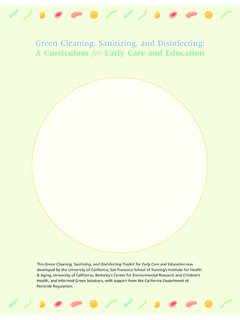Transcription of Guidance on storing pesticides for farmers and other ...
1 1 of 4 pagesHealth and Safety ExecutiveHealth and Safety ExecutiveAgriculture Information Sheet No 16(rev1)HSE information sheetGuidance on storing pesticides for farmers and other professional usersIntroductionThis information sheet provides Guidance to professional users of pesticides on suitable standards for storage. It will help professional users to meet their duties under relevant pesticide legislation. It contains advice on: fixed stores, including purpose-built stores, converted existing buildings or parts of existing buildings and small-scale storage in cabinets, chests etc; mobile stores providing short-term storage away from the home base in vehicles, on bowsers and sprayers etc; storing small amounts of particular pesticides whose hazardous chemical properties require additional precautions to be taken.
2 It does not cover the storage of methyl bromide, the storage of pesticides by suppliers (including contractors who supply pesticides ), or the transport of pesticides from suppliers to the end user . If you carry out any of these activities you should consult the DEFRA Code of Practice for suppliers of pesticides to agriculture, horticulture and forestry (the Yellow Code). If you store flammable pesticides such as antifouling products, refer to HSE s Guidance booklet The storage of flammable liquids in containers. For the purposes of this information sheet professional user means anyone who uses pesticides as part of their business or undertaking, whether as an employer or self-employed storageWhat are your storage needs? SizeThe store needs to be large enough to hold your peak pesticide requirements, any part-used containers, and able to cope with stock being held over due to poor the likely total of stocks to be held at any one time include pesticides such as slug pellets, rodenticides and wood treatment products.
3 Check if you need to make additional provision for storing any of the special classes of pesticides listed at the end of this the need to store other potentially harmful chemicals and allow for likely amounts. Provide adequate storage for rinsed empty containers awaiting disposal. Check what other facilities you may need to provide (eg storage for contaminated equipment, personal protective equipment, washing facilities etc) by reading the code of practice relevant to your pesticide work (see Further reading ). Remember that if the store is too small it leaves staff working in cramped conditions, often having to move one product to get to another. Location Before creating new storage, check with: your local authority planning department you may need planning permission for your store; the Environment Agency (EA), or in Scotland the Scottish Environment Protection Agency (SEPA).
4 You may be in an environmentally sensitive area such as a groundwater protection zone or upstream of water supply catchment areas. Site your store away from areas that present a risk of fire and at least four metres away from: hay, straw, diesel, oils, paints, fertilisers, paper, wood stacks, gas containers and other combustible materials; domestic dwellings or sources of ignition such as grain driers or welding/grinding activities. Check where any contaminated fire-fighting water will drain and: do not site stores near to drains, watercourses, wells and boreholes or areas liable to flooding. 2 of 4 pagesHealth and Safety ExecutiveHelp protect against harm to humans, animal health and the environment. Make sure that: cabinet stores are not located in domestic dwellings, retail areas, staffrooms, offices or areas where human or animal food is stored or processed; access to a pesticide store within a larger building is not through such areas; all staff know what to do in the event of a chemical spillage or fire; there is ready access for pesticide deliveries or the emergency services.
5 If an incident occurs, contain and absorb any spillage with inert absorbent materials or sand. Dispose of contaminated material or liquids safely after having sought advice from EA or SEPA. Construction Your aim is to provide a store that is resistant to fire, capable of retaining leakage/spillage (eg if containers were to melt in a fire), dry, frost-free, adequately ventilated and secure against unauthorised access. Take the following factors into account: General principles applying to all stores The store, including any doors but not the roof, should be made of materials which will resist fire for 30 minutes or longer. The store, or the area in which the store is located, should be able to retain leakage or spillage to a volume of 110% of the total quantity of products likely to be stored (185% if you are in an environmentally sensitive area ).
6 Bunding is the most usual way of achieving this. The bund should be soundly constructed of non- fragile materials resistant to permeation by liquids, eg metal (not foil), concrete, bricks, stone slabs and concrete products. Rendering or sealing the building materials may be necessary, especially at joints. The bund should comprise, or extend around, the whole periphery of the store, and should not be compromised by, for example, entrances and exits, or apertures where services enter the store. Bunding may be achieved by standing your pesticides within a metal container of sufficient capacity, eg a redundant water tank. Before converting any storage tank to form a store or bund, make sure that it is suitable and not contaminated and that flammable liquids/gases are purged. Make sure doors/lids and windows provide adequate security and are kept locked or otherwise secure when not in use.
7 Avoid having a water supply passing through the bunded area. The store itself, or the area in which it stands, should be roofed. Purpose-designed buildings Remember the general principles and note that: bunds are best constructed as an integral part of the foundations, floor and walls and sunk below ground level; where ramps are to be installed for forklift handling of pesticides , their slope should be gentle enough to avoid destabilising the load (eg < 5 slope). Converting existing structures detached buildings Make sure your selected building/area meets the general principles and: remove combustible materials; create a sealed bund; seal off internal drains. Converting existing structures stores within larger buildings Do the same as for detached buildings, plus the following: where possible, access to the store should open directly to the outside of the building; cage-style stores are only acceptable where the construction of the store and the building in which the store is located meets the general principles, including bunding; remember that fire often spreads through the roof space consider the need for fire-resistant walls extending up to the roof.
8 Converting existing structures lorry bodies, shipping containers etc Remember the general principles and: don t use lorry bodies with wooden floors or sides; create bunding by fitting a sill across the doorway or by tilting the store away from the entrance. Ensure that there are no low-level ventilation ducts; check at regular intervals that wall-to-floor joints have not deteriorated. Cabinet/bin/chest stores Remember the general principles and: note that purpose-built proprietary cabinets for pesticide storage are available; 3 of 4 pagesHealth and Safety Executivecheck the advice in the Location section and make sure your store is robust and properly sited away from traffic; stand chest freezers with foil or plastic inner liners within a bunded area; fit metal cabinets with an internal bund or stand them within a bunded area; make all cabinets etc secure or locate them in a secure area.
9 Organising your store Mark the exterior of the store (and where it is located within a larger building, the exterior of the building) with the general danger warning sign (see diagram).Put No Smoking or Smoking and Naked Flames Forbidden prohibitory signs (see diagrams) on the exterior door of the adequate shelving so that products can be seen by staff. Store powders above liquids (liquids can leak if containers are damaged). Provide adequate lighting so that you can read the labels. Protect stocks against frost oil or gas heaters or electrical equipment with exposed elements are not suitable. Avoid storing plastic containers in direct sunlight shade windows if pallets are used to keep stocks off the floor, make sure they don t present a tripping hazard and that the bunding capacity remains adequate.
10 Lag water pipes. Provide a brush, shovel, absorbent granules/sand and an impermeable container to deal with any spillages or leaking drums/packages. Practice good store management by ensuring that waste cardboard packaging is removed, old stocks are used up, damaged or deteriorating containers are properly disposed of and an up-to-date stock record is kept (away from the store). Keep an accurate stock record available as well as useful telephone numbers, including your local fire service and EA (or SEPA in Scotland). Mobile storage This Guidance applies to storage, normally for less than 24-hour periods, in vehicles, bowsers and sprayers stocked from a fixed store. You should ensure all pesticides are safely transported to the application site and remain safely stored at the site. Never carry pesticides in the cabs of tractors, self-propelled sprayers or other vehicles, and consider the following key points before you carry concentrated pesticides to an application site: Use a vehicle with a floor-to-ceiling bulkhead between the driver/passenger compartment and the load compartment.















